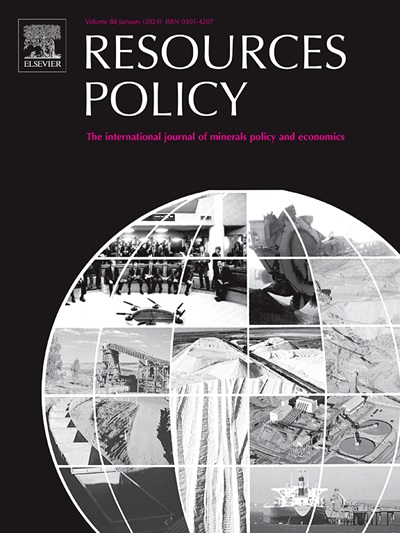全球锂贸易网络的演变特征和结构依赖性决定因素:产业链视角
IF 10.2
2区 经济学
0 ENVIRONMENTAL STUDIES
引用次数: 0
摘要
锂作为全球新兴的重要矿产,在国际贸易中的地位日益突出,了解全球锂贸易网络(GLTN)的演化和形成对能源转型和产业结构升级具有重要意义。本文从产业链角度出发,运用复杂网络理论构建了2000-2021年全球锂贸易网络(GLTN),通过指数随机图模型(ERGM)研究网络结构依赖性的决定因素,从整体和局部两个维度分析贸易网络的演化特征和形成机制。结果表明:首先,GLTN 呈现出 "上游稀疏、中下游紧密 "的网络整体特征。下游呈现出明显的小世界网络特征。中国、美国和欧洲是 GLTN 中最活跃的国家和地区,覆盖了整个产业链。其次,内生结构、节点属性和外生网络效应都会对网络结构产生影响。在网络结构依赖的影响方面,锂贸易具有传递性效应、连通性效应和流行性效应。第三,COVID-19 的冲击首先切断了对下游产业链的间接依赖所形成的传递性效应,导致网络波动性较大。产业链的网络结构依赖存在较强的异质性。本文章由计算机程序翻译,如有差异,请以英文原文为准。
Evolutionary characteristics and structural dependence determinants of global lithium trade network: An industry chain perspective
As a globally emerging critical mineral, lithium is increasingly prominent in international trade, emphasizing the importance for energy transition and industrial structure upgrading to understand the evolution and formation of the global lithium trade networks (GLTN). From the perspective of industry chain, this paper uses complex network theory to construct GLTN for 2000–2021, investigates the determinants of network structure dependence through an exponential random graph model (ERGM), for analyzing the evolutionary characteristics and formation mechanisms of trade networks in both the holistic and local dimensions. The results show that, firstly, GLTN exhibits the overall characteristics of a "sparse upstream and tight midstream and downstream" network. The downstream exhibits a distinctive small-world network feature. China, the United States and Europe are the most active countries and regions in GLTN, covering the whole industry chains. Second, endogenous structure, node attributes and exogenous network effects all exert an influence on network structure. Regarding the impact of network structural dependence, lithium trade has transitivity effect, connectivity effect, and popularity effect. Third, the shocks of COVID-19 cut off the transitivity effect formed by indirect dependencies to the downstream industry chain first, resulting in a high network volatility. There is a strong heterogeneity in the network structural dependency for the industry chain.
求助全文
通过发布文献求助,成功后即可免费获取论文全文。
去求助
来源期刊

Resources Policy
ENVIRONMENTAL STUDIES-
CiteScore
13.40
自引率
23.50%
发文量
602
审稿时长
69 days
期刊介绍:
Resources Policy is an international journal focused on the economics and policy aspects of mineral and fossil fuel extraction, production, and utilization. It targets individuals in academia, government, and industry. The journal seeks original research submissions analyzing public policy, economics, social science, geography, and finance in the fields of mining, non-fuel minerals, energy minerals, fossil fuels, and metals. Mineral economics topics covered include mineral market analysis, price analysis, project evaluation, mining and sustainable development, mineral resource rents, resource curse, mineral wealth and corruption, mineral taxation and regulation, strategic minerals and their supply, and the impact of mineral development on local communities and indigenous populations. The journal specifically excludes papers with agriculture, forestry, or fisheries as their primary focus.
 求助内容:
求助内容: 应助结果提醒方式:
应助结果提醒方式:


